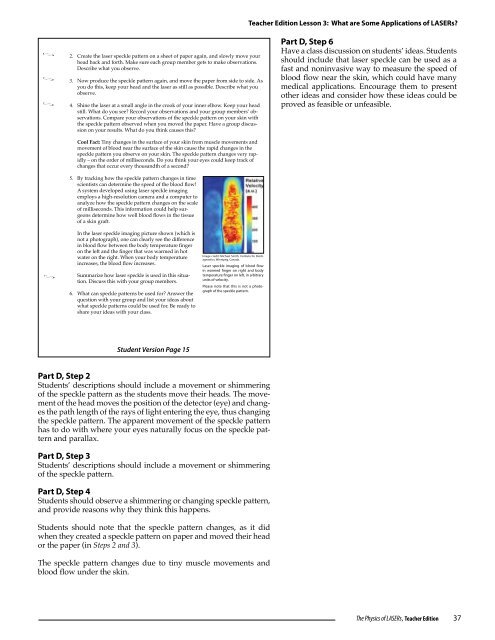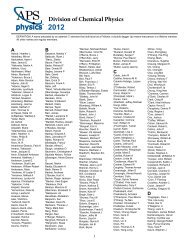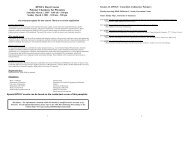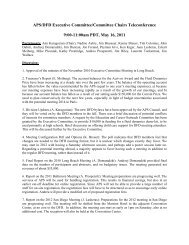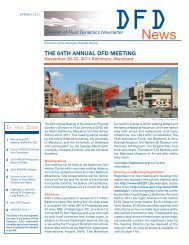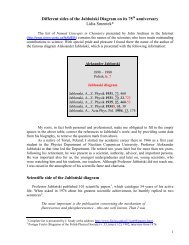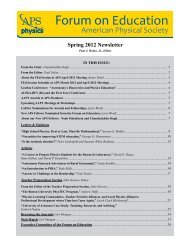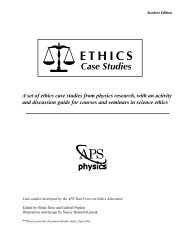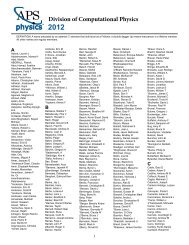The Physics of LASERs - American Physical Society
The Physics of LASERs - American Physical Society
The Physics of LASERs - American Physical Society
Create successful ePaper yourself
Turn your PDF publications into a flip-book with our unique Google optimized e-Paper software.
Student Edition Lesson 3: What are Some Applications <strong>of</strong> LASERS?<br />
16<br />
<strong>The</strong> <strong>Physics</strong> <strong>of</strong> <strong>LASERs</strong><br />
2. Create the laser speckle pattern on a sheet <strong>of</strong> paper again, and slowly move your<br />
head back and forth. Make sure each group member gets to make observations.<br />
Describe what you observe.<br />
3. Now produce the speckle pattern again, and move the paper from side to side. As<br />
you do this, keep your head and the laser as still as possible. Describe what you<br />
observe.<br />
4. Shine the laser at a small angle in the crook <strong>of</strong> your inner elbow. Keep your head<br />
still. What do you see? Record your observations and your group members’ observations.<br />
Compare your observations <strong>of</strong> the speckle pattern on your skin with<br />
the speckle pattern observed when you moved the paper. Have a group discussion<br />
on your results. What do you think causes this?<br />
Cool Fact: Tiny changes in the surface <strong>of</strong> your skin from muscle movements and<br />
movement <strong>of</strong> blood near the surface <strong>of</strong> the skin cause the rapid changes in the<br />
speckle pattern you observe on your skin. <strong>The</strong> speckle pattern changes very rapidly<br />
– on the order <strong>of</strong> milliseconds. Do you think your eyes could keep track <strong>of</strong><br />
changes that occur every thousandth <strong>of</strong> a second?<br />
5. By tracking how the speckle pattern changes in time<br />
scientists can determine the speed <strong>of</strong> the blood flow!<br />
A system developed using laser speckle imaging<br />
employs a high-resolution camera and a computer to<br />
analyze how the speckle pattern changes on the scale<br />
<strong>of</strong> milliseconds. This information could help surgeons<br />
determine how well blood flows in the tissue<br />
<strong>of</strong> a skin graft.<br />
In the laser speckle imaging picture shown (which is<br />
not a photograph), one can clearly see the difference<br />
in blood flow between the body temperature finger<br />
on the left and the finger that was warmed in hot<br />
water on the right. When your body temperature<br />
increases, the blood flow increases.<br />
Summarize how laser speckle is used in this situation.<br />
Discuss this with your group members.<br />
6. What can speckle patterns be used for? Answer the<br />
question with your group and list your ideas about<br />
what speckle patterns could be used for. Be ready to<br />
share your ideas with your class.<br />
Student Version Page 15<br />
Image credit: Michael Smith, Institute for Biodiagnostics,<br />
Winnipeg, Canada.<br />
Laser speckle imaging <strong>of</strong> blood flow<br />
in warmed finger on right and body<br />
temperature finger on left, in arbitrary<br />
units <strong>of</strong> velocity.<br />
Please note that this is not a photograph<br />
<strong>of</strong> the speckle pattern.<br />
Part D, Step 2<br />
Students’ descriptions should include a movement or shimmering<br />
<strong>of</strong> the speckle pattern as the students move their heads. <strong>The</strong> movement<br />
<strong>of</strong> the head moves the position <strong>of</strong> the detector (eye) and changes<br />
the path length <strong>of</strong> the rays <strong>of</strong> light entering the eye, thus changing<br />
the speckle pattern. <strong>The</strong> apparent movement <strong>of</strong> the speckle pattern<br />
has to do with where your eyes naturally focus on the speckle pattern<br />
and parallax.<br />
Part D, Step 3<br />
Students’ descriptions should include a movement or shimmering<br />
<strong>of</strong> the speckle pattern.<br />
Part D, Step 4<br />
Students should observe a shimmering or changing speckle pattern,<br />
and provide reasons why they think this happens.<br />
Students should note that the speckle pattern changes, as it did<br />
when they created a speckle pattern on paper and moved their head<br />
or the paper (in Steps 2 and 3).<br />
<strong>The</strong> speckle pattern changes due to tiny muscle movements and<br />
blood flow under the skin.<br />
Teacher Edition Lesson 3: What are Some Applications <strong>of</strong> <strong>LASERs</strong>?<br />
Part D, Step 6<br />
Have a class discussion on students’ ideas. Students<br />
should include that laser speckle can be used as a<br />
fast and noninvasive way to measure the speed <strong>of</strong><br />
blood flow near the skin, which could have many<br />
medical applications. Encourage them to present<br />
other ideas and consider how these ideas could be<br />
proved as feasible or unfeasible.<br />
<strong>The</strong> <strong>Physics</strong> <strong>of</strong> <strong>LASERs</strong>, Teacher Edition<br />
37


